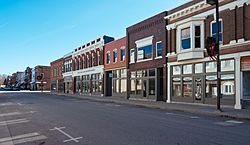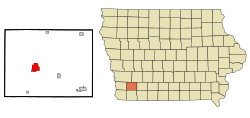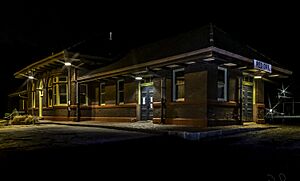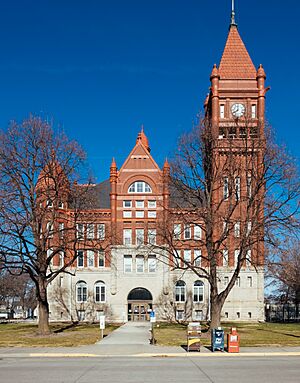Red Oak, Iowa facts for kids
Quick facts for kids
Red Oak, Iowa
|
||
|---|---|---|
 |
||
|
||

Location of Red Oak, Iowa
|
||
| Country | ||
| State | ||
| County | Montgomery | |
| Area | ||
| • Total | 3.98 sq mi (10.31 km2) | |
| • Land | 3.93 sq mi (10.17 km2) | |
| • Water | 0.06 sq mi (0.15 km2) | |
| Elevation | 1,056 ft (322 m) | |
| Population
(2020)
|
||
| • Total | 5,596 | |
| • Density | 1,425.37/sq mi (550.37/km2) | |
| Time zone | UTC-6 (Central (CST)) | |
| • Summer (DST) | UTC-5 (CDT) | |
| ZIP codes |
51566, 51591
|
|
| Area code(s) | 712 | |
| FIPS code | 19-66135 | |
| GNIS feature ID | 2396337 | |
Red Oak is a city in Iowa, United States. It is the main city and county seat of Montgomery County. The city is located along the East Nishnabotna River. In the 2020 census, 5,596 people lived in Red Oak. This was a decrease from 6,197 people in the 2000 census.
Contents
History of Red Oak, Iowa
Red Oak gets its name from Red Oak Creek. This creek flows through the area and was known for the many red oak trees on its banks. The first people to settle here arrived in the 1850s.
Becoming the County Seat
In 1865, Red Oak became the official county seat of Montgomery County. Before this, the courthouse was in Frankfort, Iowa, about seven miles northeast. During a snowstorm, the old courthouse was moved to Red Oak. It stayed there until the current Montgomery County Courthouse was built in 1891. This courthouse is now listed on the National Register of Historic Places.
The Railroad and Red Oak Junction
The city of Red Oak was officially started in 1869. This happened when the Chicago, Burlington and Quincy Railroad arrived. At that time, it was called the Burlington and Missouri River Railroad. The railroad named the community Red Oak Junction on March 20, 1876. This "junction" was a special train line. It connected the main line from Chicago to Council Bluffs, Iowa with lines going to Nebraska City, Nebraska and Lincoln, Nebraska.
The name "Junction" was removed in 1901. However, Red Oak still celebrates its history every summer with an event called Junction Days. In 1903, the railroad opened a train depot. People have been working to save this old depot since 1993. Today, it is the Restored BN and World War II Museum. This museum honors the city's important military history. It also remembers the many people from Red Oak who were lost during World War II and other wars. The depot is one of nine places in Montgomery County on the National Register of Historic Places listings in Montgomery County, Iowa.
Red Oak's Military Contributions
Red Oak has a strong history of its citizens serving in the military.
Civil War Service
During the American Civil War, the Red Oak area provided more soldiers for the Union Army than any other place in Iowa. For example, Company M had 250 members. Out of these, 160 were lost, and 52 men were killed in battle.
World War II Sacrifices
Red Oak also faced many losses in World War II. In the Battle of Kasserine Pass in February 1943, 45 soldiers from Red Oak were captured or killed. More than 100 telegrams arrived in the city saying soldiers were missing. To honor Red Oak's sacrifices, a "victory ship" was named after the city. This ship, the SS Red Oak Victory, is now a museum in Richmond, California.
The old Burlington Northern train depot has been turned into the Restored BN Depot and World War II Museum. It tells the story of Red Oak's military history.
Other Historical Facts
The Red Oak School District was created in 1870. The Red Oak Express newspaper was first published by Webster Eaton in 1868.
Geography and Climate
Red Oak is located at 41°0′42″N 95°13′38″W / 41.01167°N 95.22722°W.
Land and Water
The United States Census Bureau states that Red Oak covers about 4.01 square miles (10.39 square kilometers). Most of this area, about 3.95 square miles (10.23 square kilometers), is land. The remaining 0.06 square miles (0.16 square kilometers) is water.
Weather in Red Oak
Red Oak has a climate with warm summers and cold winters. The weather can change a lot throughout the year.
| Climate data for Red Oak, Iowa (1991–2020, extremes 1897–present) | |||||||||||||
|---|---|---|---|---|---|---|---|---|---|---|---|---|---|
| Month | Jan | Feb | Mar | Apr | May | Jun | Jul | Aug | Sep | Oct | Nov | Dec | Year |
| Record high °F (°C) | 69 (21) |
78 (26) |
91 (33) |
94 (34) |
101 (38) |
104 (40) |
109 (43) |
106 (41) |
103 (39) |
94 (34) |
82 (28) |
73 (23) |
109 (43) |
| Mean maximum °F (°C) | 55.6 (13.1) |
61.1 (16.2) |
75.4 (24.1) |
85.3 (29.6) |
90.3 (32.4) |
93.1 (33.9) |
95.4 (35.2) |
94.4 (34.7) |
91.8 (33.2) |
85.8 (29.9) |
70.7 (21.5) |
59.2 (15.1) |
97.2 (36.2) |
| Mean daily maximum °F (°C) | 32.8 (0.4) |
37.8 (3.2) |
50.9 (10.5) |
63.2 (17.3) |
73.4 (23.0) |
82.8 (28.2) |
86.3 (30.2) |
84.7 (29.3) |
78.4 (25.8) |
65.7 (18.7) |
50.3 (10.2) |
37.4 (3.0) |
62.0 (16.7) |
| Daily mean °F (°C) | 22.7 (−5.2) |
27.1 (−2.7) |
39.3 (4.1) |
50.7 (10.4) |
62.1 (16.7) |
72.1 (22.3) |
75.9 (24.4) |
73.7 (23.2) |
65.8 (18.8) |
53.2 (11.8) |
39.1 (3.9) |
27.6 (−2.4) |
50.8 (10.4) |
| Mean daily minimum °F (°C) | 12.5 (−10.8) |
16.4 (−8.7) |
27.7 (−2.4) |
38.3 (3.5) |
50.8 (10.4) |
61.4 (16.3) |
65.5 (18.6) |
62.7 (17.1) |
53.2 (11.8) |
40.6 (4.8) |
27.8 (−2.3) |
17.9 (−7.8) |
39.6 (4.2) |
| Mean minimum °F (°C) | −10.1 (−23.4) |
−3.6 (−19.8) |
7.8 (−13.4) |
22.6 (−5.2) |
35.9 (2.2) |
47.8 (8.8) |
54.2 (12.3) |
52.0 (11.1) |
37.4 (3.0) |
24.9 (−3.9) |
12.2 (−11.0) |
−3.0 (−19.4) |
−14.0 (−25.6) |
| Record low °F (°C) | −27 (−33) |
−28 (−33) |
−22 (−30) |
2 (−17) |
26 (−3) |
34 (1) |
39 (4) |
34 (1) |
23 (−5) |
13 (−11) |
−14 (−26) |
−26 (−32) |
−28 (−33) |
| Average precipitation inches (mm) | 0.88 (22) |
1.11 (28) |
2.03 (52) |
3.83 (97) |
5.95 (151) |
5.44 (138) |
3.96 (101) |
3.89 (99) |
3.58 (91) |
3.31 (84) |
1.88 (48) |
1.38 (35) |
37.24 (946) |
| Average snowfall inches (cm) | 7.3 (19) |
8.1 (21) |
2.6 (6.6) |
1.2 (3.0) |
0.0 (0.0) |
0.0 (0.0) |
0.0 (0.0) |
0.0 (0.0) |
0.0 (0.0) |
0.5 (1.3) |
1.2 (3.0) |
6.5 (17) |
27.4 (70) |
| Average precipitation days (≥ 0.01 in) | 5.4 | 6.6 | 8.0 | 10.9 | 13.5 | 11.0 | 9.5 | 8.9 | 8.0 | 8.0 | 6.3 | 6.3 | 102.4 |
| Average snowy days (≥ 0.1 in) | 3.7 | 4.2 | 1.4 | 0.5 | 0.0 | 0.0 | 0.0 | 0.0 | 0.0 | 0.3 | 1.1 | 3.7 | 14.9 |
| Source: NOAA | |||||||||||||
Population and People
Red Oak has seen changes in its population over the years.
| Historical population | |||
|---|---|---|---|
| Census | Pop. | %± | |
| 1870 | 1,315 | — | |
| 1880 | 3,755 | 185.6% | |
| 1890 | 3,321 | −11.6% | |
| 1900 | 4,355 | 31.1% | |
| 1910 | 4,830 | 10.9% | |
| 1920 | 5,578 | 15.5% | |
| 1930 | 5,778 | 3.6% | |
| 1940 | 5,763 | −0.3% | |
| 1950 | 6,526 | 13.2% | |
| 1960 | 6,421 | −1.6% | |
| 1970 | 6,210 | −3.3% | |
| 1980 | 6,810 | 9.7% | |
| 1990 | 6,264 | −8.0% | |
| 2000 | 6,197 | −1.1% | |
| 2010 | 5,742 | −7.3% | |
| 2020 | 5,596 | −2.5% | |
| U.S. Decennial Census | |||
2020 Population Details
Based on the census from 2020, Red Oak had 5,596 people. There were 2,454 households and 1,407 families living in the city. The city's population density was about 1,425 people per square mile (550 per square kilometer). There were 2,795 homes, with an average of 712 homes per square mile (275 per square kilometer).
Most people in Red Oak were White (91.7%). Other groups included Black (0.3%), Native American (0.5%), and Asian (0.4%). About 2.7% were from other races, and 4.4% were from two or more races. Hispanic or Latino people made up 5.5% of the population.
About 25.6% of households had children under 18. Many households (39.6%) were married couples. The average age in Red Oak was 42.6 years. About 25.8% of residents were under 20 years old. The city's population was 48.4% male and 51.6% female.
2010 Population Details
In the 2010 census, Red Oak had 5,742 people living in 2,481 households. This included 1,475 families. The population density was about 1,453 people per square mile (561 per square kilometer). There were 2,887 housing units.
The racial makeup of the city was mostly White (96.3%). Other groups included African American (0.3%), Native American (0.4%), and Asian (0.2%). About 1.4% were from other races, and 1.3% were from two or more races. Hispanic or Latino people made up 4.2% of the population.
About 28.7% of households had children under 18. The average household had 2.26 people, and the average family had 2.90 people. The median age was 42.2 years. About 24.4% of residents were under 18. The city's population was 47.6% male and 52.4% female.
Healthcare in Red Oak
Red Oak is home to the Montgomery County Memorial Hospital (MCMH). This is a modern hospital with 25 beds. It provides healthcare services for people of all ages, from birth to hospice care. MCMH focuses on providing good healthcare for the local community, both inside the hospital and through special programs outside of it.
Hospital History
The hospital started in 1920 as Red Oak Hospital. Dr. B.F. Gillmor opened it with 15 beds. In 1931, it was renamed Murphy Memorial Hospital. This was to honor a gift of $40,000 from Thomas D. and Ina C. Murphy.
In 1941, a new 26-bed hospital was built in a different location. More additions were made in 1951. In 1961, a long-term care unit called Highland Acres was built. In 1978, voters decided that Montgomery County should own Murphy Memorial Hospital. It then became known as Montgomery County Memorial Hospital. A new hospital building was built in 1989, and a Physicians Center was added in 1993.
Education in Red Oak
The Red Oak Community School District is in charge of the public schools in Red Oak.
Interesting Facts About Red Oak
- From 1882 to 1901, Red Oak had a streetcar system pulled by horses.
- The city has a transmitter for the Iowa Public television system.
Notable People from Red Oak
Many interesting people have come from Red Oak, Iowa:
- Dennis Ashbaugh – a famous painter.
- James R. Bennett – served as the Secretary of State of Alabama.
- Lou Blonger – a saloon owner from the Wild West.
- Johnny Carson – a very well-known entertainer and host of The Tonight Show Starring Johnny Carson.
- Clyde Cessna – the person who started the Cessna Aircraft Company.
- Horace E. Deemer – a Chief Justice of the Iowa Supreme Court.
- Thomas Harlan Ellett – an NYC architect.
- Joni Ernst – a Republican member of the Iowa Senate and a junior member of the United States Senate.
- Ida M. Evans – a short story writer.
- Kenneth A. Evans – a Republican member of the Iowa Senate and Lieutenant Governor of Iowa.
- Kurt Griffey – a guitarist for Creedence Clearwater Revisited.
- Raymond Hatton – an actor.
- Elvin Hutchison – a running back for the Detroit Lions and an NFL official.
- James E. Kearney – a Roman Catholic bishop.
- Dick Kenworthy – a Major League Baseball third baseman for the Chicago White Sox.
- John Milton Killits – a United States federal judge.
- John Logan (poet) – a poet and professor.
- Smith McPherson – served as Iowa Attorney General.
- L. Welch Pogue – an aviation lawyer and chairman of the Civil Aeronautics Board.
- Stephen Shortridge – an actor.
- Con Starkel – a Major League Baseball pitcher for the Washington Senators.
- Duane Thompson – an actress from silent films.
- Nellie Walker – a sculptor known for her statue of James Harlan in the National Statuary Hall Collection.
- Fred Lawrence Whipple – an astronomer who created the Whipple shield and was a professor at Harvard University.
See also
 In Spanish: Red Oak (Iowa) para niños
In Spanish: Red Oak (Iowa) para niños





